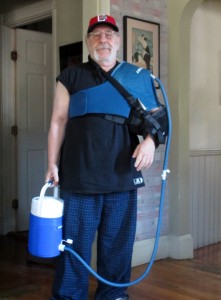 I knew there was a problem the moment it happened. First snowfall of the winter and the first winter without Jake’s young, brawny arms living with us. Sue was crystal clear: stay inside and she’d dig everything out.
I knew there was a problem the moment it happened. First snowfall of the winter and the first winter without Jake’s young, brawny arms living with us. Sue was crystal clear: stay inside and she’d dig everything out.
I waited until she geared up, went downstairs and began digging before I dressed and followed. Sue started yelling as soon as she saw me, but I pretended not to hear. No way I was gonna let her do the porch, stairs, walks, and cars by herself.
I knew enough to protect my right shoulder from any heavy lifting given my surgeon’s warnings that the last operation was a “one and done” deal. But I was too dumb to protect my left shoulder from overcompensating.
By the time I was back upstairs my left was throbbing and I should have let her shovel alone because a steady diet of Advil reduced the pain, but never took it away.
You might think one dumb was enough. Not me. Why stick with one when there’s more on the table? Rather than going to my doctor as soon as I realized the hurt wasn’t about to vanish, I decided to just live with it until just before Sue and I went to Mexico in the spring. Then I paid a call to my doc and received a cortisone shot to be as pain-free as possible during the trip. I also really harbored a belief that the shot would clear up the problem once and for all.
Well, at least it worked for the trip but not the “once and for all.”
Still, I hesitated making another doctor’s appointment upon our return. My gut knew another doctor visit meant another operation.
I finally went and my “gut” came true. But what surprised me was the surgeon’s announcement that the surgery had to be done the following week. I had dreamed of delaying it for a year—or, at least until after November so I could introduce myself to my newly born twin granddaughters without looking like a monster movie poster. And be able to somewhat comfortably hold them.
Wasn’t happening. He made it absolutely clear that that any delay would cost too much range of motion in my arm.
Suddenly the operation became a no brainer.
Nevertheless this “no brainer” filled my head with dread. I remembered all too well being stuck in a recliner, unable to get out on my own, for months and months. Remembered all the times I had to call Jake in the middle of the night to help me out so I could use the john. And this time there’d be no Jake to call.
Nor was it going to be six months. Turns out there’s a new way to do shoulder surgeries and while the recovery pain is the same, the recovery time has been greatly reduced. This recovery period was just gonna be around six weeks, but the pain will be much better than my other arm when all is healed. Which Jake reminds me of every time I start feeling sorry for myself.
And no, he hasn’t moved back into the house. He used brain, not brawn. He Craiglisted to find and buy a motorized recliner that allows me to get in and out by myself. It really has made this recovery a whole lot more tolerable.
Truth is, this is really just a 1st World problem. People throughout the globe live without doctors, painkillers, operations, and limbs.
Which, in some ways has made sitting in the house more difficult. Every morning coffee is filled with newspaper horror stories. Makes me sick while I sit around waiting to use my arm. And man, after reading the papers I really want to hit something.
But that’s a price you pay when living in the belly of the beast. The contradiction of a life comfortably lived—shoulder pain or not—while most of the world exists in squalor.
Only these days I’m much less focused on my own life contradictions and much more concerned about the lives of all the kids and twins. What goes around, comes around is never far from my mind. Fact is, we can’t be bogarting most of the world’s resources and imagine this can last forever. There will be a price.
So I mostly focus on my return to writing, try to be a decent partner, friend, and father. Which I’m sure, like the shoulder I fucked up, I’ll mess up more than once. Nonetheless, I’ll keep trying.
The world will take us where it wants despite our meat-headed grandiosity.
 In any event, it’s good to be back writing Just sayin’ and once the meds actually wear off I hope to fill the columns with more outrage, reviews, hopes and Interviews with the Dead. In other words facts, fiction, and guest posts. In other words, I’m back.
In any event, it’s good to be back writing Just sayin’ and once the meds actually wear off I hope to fill the columns with more outrage, reviews, hopes and Interviews with the Dead. In other words facts, fiction, and guest posts. In other words, I’m back.
I also want to thank Kent Ballard for the last column. I found it moving, thought provoking, and deeply personal. What I call “writing from the heart.” Thanks, friend.
You can’t depend on your eyes when your imagination is out of focus. ~ Mark Twain












